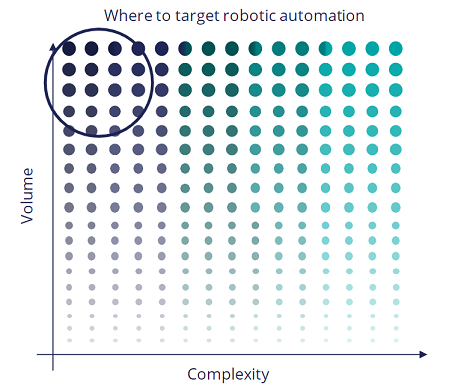
Pega Robotic Automation use cases
Pega Robotic Automation
Pega Robotic Automation helps achieve goals faster and more efficiently by automating everyday tasks and freeing up resources from manual, repetitive work. Robotic automation is a style of automation where a software robot mimics the work of human users to perform various actions. A software robot designed with specific automated steps executes a workflow involving multiple tasks and interactions with different applications.
To illustrate the use of robotic automation, consider the following examples:
A banking employee starts each day by opening, logging in, and then arranging many applications on his desktop. With Pega Robotic Automation, the employee can activate a robot that automatically performs all those tasks.
An employee processes a loan application for a customer and invokes another robot that logs into a system of record to retrieve customer data. Once the robot receives and returns the customer data, the robot logs in to another banking application to complete the loan application process. When the loan application submission process completes, the robot returns a confirmation to the employee.
Attended and unattended automations
Pega Robotics facilitates communication between multiple applications and automates the repeatable steps of the process. Depending on the company setup and particular use case, the robotic automation solution can be developed as attended or unattended.
Attended mode automations are typically short, immediate, repetitive tasks that assist in some human decisioning or involvement. Unattended automations consist of long, repetitive processes that can work independently, without user intervention. Overall, when trying to determine if an automation is a viable option, consider the volume or repetition and the complexity of the task.
Automation possibilities
When considering procedures to implement as unattended automations, watch for the following characteristics:
- Well-defined
- Rules-driven and not dependent on a human decision
- Simple to medium complexity
- High volume
- Not time-sensitive
Procedures that are automated in an attended mode have the following characteristics:
- Well-defined
- Rules-driven (allows human decisioning)
- Simple
- High volume
- Performed across many verticals
- Must execute quickly
Benefits of Pega Robotic Automation
With Pega Robotic Automations in place, companies have the opportunity to reallocate employees to perform higher-value work driving down the cost to serve, increase work throughput, create greater operational efficiency, and ultimately enhance the customer experience.
Pega Robotic Automation can support the Pega Platform™ by automating front-end applications that do not have an API or where the API is insufficient or not accessible. Pega Robotic Automation automates steps or processes through the user interface of the application instead of using an API for these applications.
Many robotic projects are built in conjunction with the Pega Platform. The Pega Platform application invokes or queues the automation to perform particular steps to return data to the case life cycle or completes the case life cycle.
Example use cases
Many organizations use similar types of tasks and procedures that are performed more efficiently using robotic automation. There are out-of-the-box components to assist with quickly automating common use cases.
Consider a customer support representative (CSR) who works in the banking industry. The banking organization deploys Pega Robotic Automation to start from one or more of these easily configured automations:
- Assisted Sign-On: CSRs automatically log in applications at the beginning of the day with a single click or on-demand when accessed.
- Start My Day: CSRs and back-office workers specify the order in that they want applications to launch to keep them organized and optimized for readiness at all times.
- Search and 360-degree customer view: Retrieves contextually relevant customer data from disparate applications in a centralized, easy-to-consume format so that CSRs have the data they need to service a transaction at a glance.
- Auto Notes: Tracks work activities and generate notes automatically to accelerate post-call wrap-up.
- Shortcuts and wizards: Prebuilt core task shortcuts can launch mission-critical processes and business activities, provide process guidance, verify data entry, and enforce compliance.
- Reset to Ready State: Clears the screens and resets the screens to be ready for the next transaction once a transaction is complete.
More complex example use cases for both attended and unattended modes can include the following:
- Changing the personal data of the client
- Changing account details, such as update address, add user, and change name
- Transaction fulfillment (such as Account Opening, Data Synchronization, and Confirmations)
- Password resets
- Close accounts
- Automate email notifications on cases
- Onboarding/Offboarding employees (Application assignments, hardware assignments, office location)
- Payments
- Skip or adjust payments
- Loan application
- Debt cancellation
- Collections
- Deposit rates update
- Add new claim
- Data extraction from documents
- Contextual default data and data verification
- Online client services (real-time interaction with systems)
- Cross-sell (next best action on additional products)
This Topic is available in the following Modules:
If you are having problems with your training, please review the Pega Academy Support FAQs.
Want to help us improve this content?
